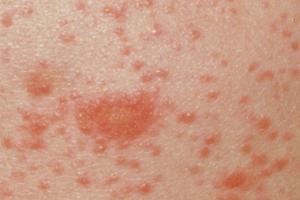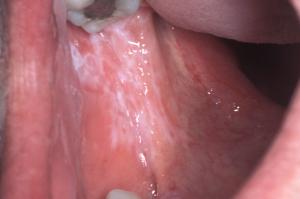Lichen planus
Lichen planus is a non-infectious rash that can affect different parts of your body, including the inside of your mouth. You should see your GP if you think you might have it.
When to see your GP
See a GP if you have:
- clusters of shiny, raised, purple-red blotches on your arms, legs or body (you may see fine white lines on the blotches)
- white patches on your gums, tongue or the insides of your cheeks
- burning and stinging in your mouth, especially when you eat or drink
- bald patches appearing on your scalp
- sore red patches on your vulva
- rough, thinning nails with grooves on
- ring-shaped purple or white patches on your penis

You may only have one of these symptoms.
It is not known what causes it, though it is suspected that it may be caused by an autoimmune problem (where a person’s own immune system mistakenly attacks their body).
Lichen planus on your skin can be very itchy, but not always. You can't catch lichen planus. It doesn't usually come back once it's cleared up.

It often appears on the inside of your wrist. White patches in your mouth may be lichen planus.
Other possible causes of a rash
Below are some possible causes and symptoms of rashes.
But don’t self-diagnose – see your GP if you’re worried about your symptoms.
- psoriasis - red, flaky, crusty patches, often on elbows or knees
- pityriasis rosea - raised, red, scaly patches on the body
- lichen sclerosus - itching and white patches on the vulva
- ringworm - ring-like red patch anywhere on the body
- eczema - itchy, dry, cracked, sore and red skin
Treatments from a GP
Lichen planus on your skin usually gets better on its own in about six to nine months.
If you need treatment, your GP will discuss your options with you.
Creams and ointments from your GP can help control the rash and ease itching.
If creams and ointments don't work, or you have severe lichen planus, steroid tablets or treatment with a special kind of light (light therapy) can help.
Lichen planus in your mouth can last for several years.
Mouthwashes and sprays from your GP can help ease symptoms, like burning or sore gums.
How to relieve lichen planus at home
If you have lichen planus on your skin, there are things you can do to relieve the symptoms. These include:
- washing with plain, warm water – avoid soaps and body washes
- washing your hair over a sink or bath, so the shampoo doesn't come into contact with the rest of your skin
- using an emollient (moisturising treatment for the skin) on the rash
If the lichen planus is on your vulva, it may also help if you:
- use petroleum jelly before and after weeing
- hold a bag of frozen peas, wrapped in a clean tea towel, against the affected bits, to ease itching and swelling
- avoid wearing tights
If you have it in your mouth, there are things you can do to relieve the symptoms. These include:
- brushing your teeth carefully twice a day to keep your gums healthy
- avoiding salty, spicy or acidic foods if they make your mouth sore
- avoiding alcohol and mouthwashes that contain it
More useful links
The information on this page has been adapted from original content from the NHS website.
For further information see terms and conditions.